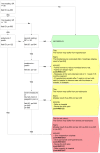"Quality of prenatal and maternal care: bridging the know-do gap" (QUALMAT study): an electronic clinical decision support system for rural Sub-Saharan Africa
- PMID: 23574764
- PMCID: PMC3637082
- DOI: 10.1186/1472-6947-13-44
"Quality of prenatal and maternal care: bridging the know-do gap" (QUALMAT study): an electronic clinical decision support system for rural Sub-Saharan Africa
Abstract
Background: Despite strong efforts to improve maternal care, its quality remains deficient in many countries of Sub-Saharan Africa as persistently high maternal mortality rates testify. The QUALMAT study seeks to improve the performance and motivation of rural health workers and ultimately quality of primary maternal health care services in three African countries Burkina Faso, Ghana, and Tanzania. One major intervention is the introduction of a computerized Clinical Decision Support System (CDSS) for rural primary health care centers to be used by health care workers of different educational levels.
Methods: A stand-alone, java-based software, able to run on any standard hardware, was developed based on assessment of the health care situation in the involved countries. The software scope was defined and the final software was programmed under consideration of test experiences. Knowledge for the decision support derived from the World Health Organization (WHO) guideline "Pregnancy, Childbirth, Postpartum and Newborn Care; A Guide for Essential Practice".
Results: The QUALMAT CDSS provides computerized guidance and clinical decision support for antenatal care, and care during delivery and up to 24 hours post delivery. The decision support is based on WHO guidelines and designed using three principles: (1) Guidance through routine actions in maternal and perinatal care, (2) integration of clinical data to detect situations of concern by algorithms, and (3) electronic tracking of peri- and postnatal activities. In addition, the tool facilitates patient management and is a source of training material. The implementation of the software, which is embedded in a set of interventions comprising the QUALMAT study, is subject to various research projects assessing and quantifying the impact of the CDSS on quality of care, the motivation of health care staff (users) and its health economic aspects. The software will also be assessed for its usability and acceptance, as well as for its influence on workflows in the rural setting of primary health care in the three countries involved.
Conclusion: The development and implementation of a CDSS in rural primary health care centres presents challenges, which may be overcome with careful planning and involvement of future users at an early stage. A tailored software with stable functionality should offer perspectives to improve maternal care in resource-poor settings.
Trial registration: ClinicalTrials.gov NCT01409824.
Figures










References
-
- WHO. Trends in maternal mortality: 1990 to 2010. Estimates developed by WHO, UNICEF, UNFPA and The World Bank. Geneva: WHO; 2012.
-
- WHO. Levels and trends in child mortality. Estimates Developed by the UN Inter-agency Group for Child Mortality Estimation. Geneva: WHO; 2012.
Publication types
MeSH terms
Associated data
LinkOut - more resources
Full Text Sources
Other Literature Sources
Medical
Miscellaneous

